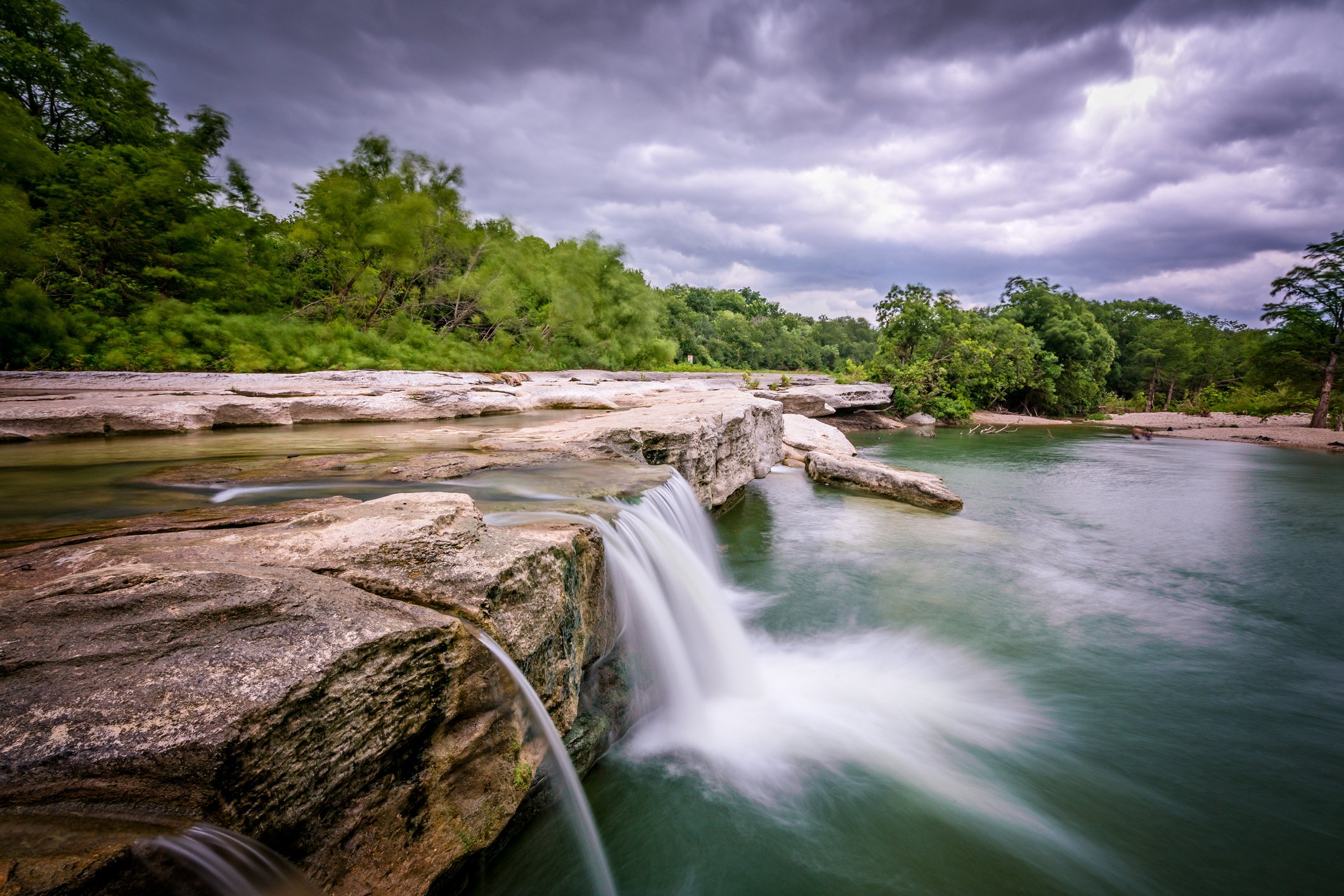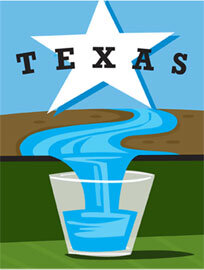
Agriculture
You Can Prevent Nonpoint Source Pollution
When rain or stormwater flows across farm and ranch lands, rooftops, lawns, streets, parking lots, construction sites, and open lots it collects all kinds of pollution from “nonpoint sources” and washes them into our rivers and streams. Typical pollutants from stormwater pollution include sediment (dirt), oil and grease, fecal coliform, pesticides and fertilizer, lawn clippings, debris, and heavy metals.
Contrary to what you might think, stormwater runoff does NOT flow into the sewer and to the wastewater treatment plant for treatment (clean up). Polluted stormwater flows directly into our freshwater rivers, streams, and lakes. It also can impact groundwater sources. Cleaning up contaminated water can be costly or not possible. Preventing pollution by applying “Best Management Practices” (or BMPs) is easier and more economical.
Stormwater Control
Stormwater pollution is a source water concern due to the increased volume and rate of runoff from impervious surfaces, and the concentration of pollutants in the runoff. In agricultural settings, infiltration, filtration, and retention/detention practices can help protect source waters.
Infiltration Best Management Practices seek to decrease the quantity of stormwater runoff by allowing the water to percolate through the ground and to increase the quality of the runoff by filtering the water. For example, grassy swales (shallow, vegetated channels) convey stormwater runoff to remove pollutants by sedimentation and infiltration.
Filtration BMPs primarily seek to increase the quality of runoff by filtering the water.
Bioretention is the practice of removing stormwater pollutants through a variety of physical, biological, and chemical treatment processes involved in soil and plant-based filtration. The process usually consists of a grass buffer strip, sand bed, ponding area, organic or mulch layer, planting soil, and plants.
Vegetated/Grassed Buffer/Filter Strips are densely vegetated areas of land that treat sheet flow before flowing into a surface water body. They decrease the velocity of the runoff, hold soils in place, allow some infiltration, and filter vegetation.
Media Filters usually consist of a settling chamber and a sand (or other media) filtration chamber designed to treat stormwater runoff.
Retention/detention ponds retain water, which decreases the quantity and increases the quality of runoff.
Stormwater/Wet Basins/Ponds are permanent pools of water that can accommodate stormwater runoff. Generally, they also include an area of vegetation around the pond to provide removal of dissolved solids. They can be distinguished from wetlands because they are generally deeper and have less vegetative cover.
Constructed Wetlands are permanent pools of water designed to treat runoff. They can be distinguished from wet ponds because they are generally shallower and have more vegetative cover.
Retention/Irrigation Systems capture stormwater runoff in a pond/basin, which then distributes the water in an irrigation system. This distribution of runoff over a large area reduces the infiltration requirements of the soil.
Extended Detention Basins/Dry Ponds are designed to detain stormwater runoff for a given period, which allows sedimentation of particulates to take place in the basin.
Integrated Pest Management
Further information can be found at these sites:
Integrated Pest Management is a safe, alternative means of managing insects, weeds, and other types of pests. Pests are identified, action thresholds are considered, all possible control options are evaluated, and selected controls are implemented. Control options used to prevent or remedy unacceptable pest activity or damage include these options:
Biological – introduce beneficial predators into landscapes
Cultural – plant native, pest-resistant plant varieties
Mechanical – hand-pick insects, or use traps, barriers, or water blasts to infected areas
Chemical – use botanical, mineral, and insecticidal soap or synthetic chemicals

Combined Animal Feeding Operations
Animals confined to feeding lots produce large quantities of manure, which can be a source of water pollution (in the form of phosphorous) if it is not properly managed and stored. Best Management Practices can be used to reduce waterway pollution.
Best Management Practices to reduce pollution of the waterways include:
-
Construct sediment basins to trap and manage solid manure
Gage runoff holding ponds to help avoid capacity issues
Build erms around manure storage to prevent runoff
Use grass filter strips to protect surface water
Use bermed feedlots and livestock yards to contain runoff
Locate feedlots on sloped lands to provide good drainage
Use concrete ditches or well-maintained grassed waterways to control effluent and carry it to a holding pool
Design storage tanks with sufficient freeboard
Cover livestock holding areas to minimize the mixing of stormwater with manure
Cover compost and manure storage areas to minimize runoff
Utilize gutters to separate clean and dirty water and prevent water from accumulating
-
Implement and follow a nutrient management plan
Use a calibrated spreader to apply manure evenly
Center pivots with low-pressure nozzles to evenly apply liquids from the holding pool to avoid runoff
-
Fence surface waters so cattle do not have direct access
Rotate pastures to provide adequate cover and prevent runoff
Use self-watering systems to prevent direct access to surface waters
Centrally locate water tanks to allow cattle rotation on different pastures
Clean solids from ditches to allow effluent to flow freely to retention ponds
Develop an emergency management system
Test soil to help determine nutrient levels and plan for land application of manure
Utilize wind-row composting to allow for recycling of manure and aid in planning for nutrient management
Secure facilities to prevent accidents and vandalism
Berm, secure and cover silage to prevent runoff
-
Beef Cattle:
EPA Information on Beef Cattle and Environmental Stewardship Opens
Dairies:
EPA Information on Dairies and Environmental Stewardship
Technical Pollution Prevention Guide for Dairy Processing Operations
Poultry:
EPA Information on Poultry Production and Environmental Stewardship
Swine:
EPA Information on Swine Production and Environmental Stewardship
Funding Sources for Implementing Agricultural Best Management Practices
Farm Service Agency
Program: Conservation Reserve
Purpose: Reduce soil erosion and sedimentation, improve water quality, and create better wildlife habitat.
Assistance: Direct payment for specified use
Use & Restrictions: Landowners receive annual payments for planting vegetative cover on highly erodible land
Eligibility Requirements: Individuals, partnerships, associations, tribal corporations, estates, trusts, other business enterprises, states
Matching Requirements: None
Contact: 202-720-6221; www.fsa.usda.gov
Natural Resources Conservation Service
Program: Environmental Quality Incentives Program
Purpose: Assist eligible farmers and ranchers in addressing soil, water, and related natural resource concerns in an environmentally beneficial and cost-effective manner.
Assistance: Direct payment for specified use
Use & Restrictions: Implementation of structural and land management practices
Eligibility Requirements: Agricultural producers facing serious threats to specified resources or needing assistance in complying with governmental environmental standards
Matching Requirements: None
Contact: 202-720-1845; www.nrcs.usda.gov
Natural Resources Conservation Service
Program: Conservation Security
Purpose: Promote conservation and improvement of soil, water, air, energy, plant, and animal life on tribal and private working lands.
Assistance: Direct payment for specified use
Use & Restrictions: Landowners receive annual payments for implementing contractually defined stewardship practices.
Eligibility Requirements: Individual producers, partnerships, associations, corporations, estates, trusts, other business or legal entities controlling eligible lands
Matching Requirements: None
Contact: 202-690-0848; www.nrcs.usda.gov
Natural Resources Conservation Service
Program: Wetlands Reserve Program
Purpose: Restore and protect farmed wetlands, prior converted wetlands, wetlands farmed under natural conditions, and certain riparian areas.
Assistance: Direct payment for specified use
Use & Restrictions: Landowners placing wetlands under a 30-year or permanent easement or restoration agreement
Eligibility Requirements: Individual landowners, partnerships, associations, corporations, estates, trusts, businesses, or states
Matching Requirements: None
Contact: 202-7690-0848; www.nrcs.usda.gov










